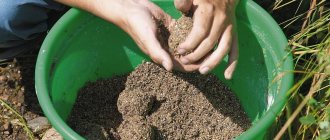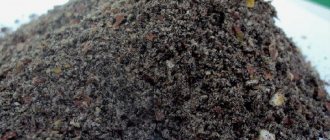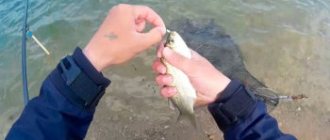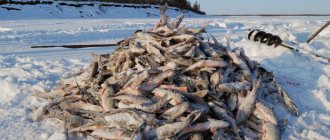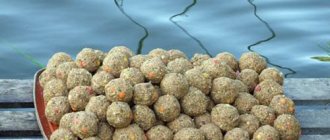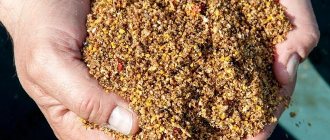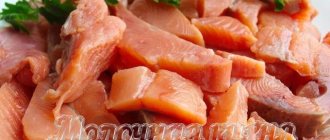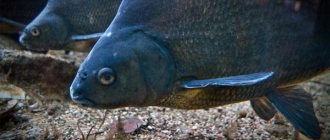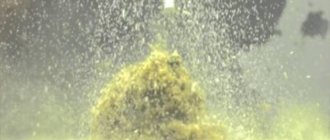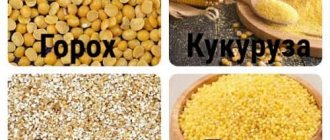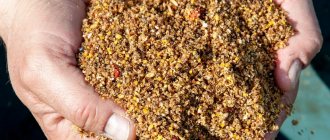Advantages and disadvantages
Like any other bait, the dough has pros and cons. The advantages are as follows:
- Easy to prepare.
- Cheap (the ingredients are available in any kitchen).
- Possibility to vary the smell and taste.
- Cuts off perches, ruffs, and other predators.
The disadvantages include:
- It quickly becomes unusable in the cold.
- Doesn't stay on the hook for long.
These disadvantages can be overcome. Just keep the dough in a warm pocket and it will remain in working condition. And the fact that it is washed away by water and comes off the hook is rather a plus. The fish will be interested in the hanging threads rather than the ball, which will lead to a bite.
Two main types of test
The dough, as a bait for catching roach and other white fish, is divided into two types:
- Thick. Flour is mixed with water until it reaches the consistency of plasticine. It doesn't stick to your fingers. It is convenient to roll balls of the desired size from it and place it on a hook.
- Viscous. It is also called chatterbox. Without a special device, which is often used as a disposable syringe, it will not be possible to place such dough on a hook. But this same syringe serves as a storage container. It fits easily in an inside pocket and is always at hand.
Equipment for fishing with dough
The first equipment for the test is called passive
It consists of a float or nod, a sinker and a hook. A leash is not needed with this setup. It is better to start fishing with such equipment on several holes, for example three will be quite enough. So on another hole you can put the same equipment, but with a nod and a jig. We lower the dough almost to the bottom and wait for the fish to approach. Only peaceful fish that are active in winter are caught using this method. Such as roach, bream and rudd. If the fish does not approach for a long time, then you need to slightly tug the bait up and down to attract the fish.
The second equipment is called wiring
Wiring of the nozzle is done calmly, without jerking. When raising and lowering, you need to pause or rock the bait. A bite on the dough is expressed weakly, by a slight twitch of the nod. Here you need to immediately make a hook.
Also watch a video about preparing bait:
I hope you liked my article. Write your opinions and comments. Happy fishing!
To Home Page.
By
A few basic recipes
To the two main ingredients - water and flour - some flavoring and nutritional components are often added.
From flour
Dough for catching roach in winter using only flour and water is not very effective. In winter, the roach tries to find high-calorie food containing protein. Powdered milk is great for this. It has the smell and taste that fish need in winter.
Cake or seeds
The taste and smell of sunflower oil when fishing for roach with dough is to the taste of the fish. However, an excess of this aroma often leads to the opposite result. To add cake or seeds, they must be thoroughly crushed. Then mix the resulting powder with dry flour, and only then add water, making sure that you get the desired consistency.
Garlic
The pungent smell of garlic spreads well even in cold water. It is very attractive to roach, and with its help you can lure fish from a large area. Before kneading, pass the head of garlic through a meat grinder or garlic grinder. Then everything is the same as in the previous case.
Potato
This option is prepared a little differently. The potatoes are boiled and kneaded well. Potatoes are added to the already prepared mass. Mix thoroughly to achieve uniform viscosity. In addition to roach, bream and even carp can be tempted by this aroma.
Dough recipes for fishing
Sunflower dough
With sunflower oil
This dough perfectly collects fish at the fishing point. After all, sunflower oil is an excellent attractant that affects the taste buds of fish.
How to make dough for fishing with sunflower oil? Just add a few drops of unrefined oil (fragrant) to the prepared lump and knead the dough thoroughly with your hands.
Oil binds the structure well, makes the dough elastic and does not stick to your hands.
With ground sunflower seeds
According to the principle of action, this fishing dough is similar to added oil. Sunflower seeds are used, which are dried and ground in a coffee grinder or twisted in a meat grinder.
Large fractions of seeds in the bait can be washed out in the water, which further attracts fish.
They add it to the finished lump, or do this - scatter the whisper on paper and roll a ball of dough over it, then knead it.
Dough with egg
A very effective way to make the dough elastic and easy to release from your fingers. In addition, the egg adds to the attractiveness of the fish bait. It's very easy to prepare. One egg is broken into a heap of flour, mixed and then kneaded, usually without any water at all, since there is enough of it in the egg.
In order not to use water, you need to follow the proportions: 2-3 tablespoons of flour per 1 egg.
Unkneadable dough (with cotton wool)
This effect can be easily achieved by adding pieces of cotton wool when kneading the dough. Cotton wool has a denser structure and holds well on the hook along with the dough.
Enough for 3 tablespoons of flour 10 - maximum 15 small pieces.
The main thing is not to overdo it with the quantity and not to squeeze the cotton into lumps. The pieces should be “airy”.
Anise dough
Preparing dough with anise oil is similar to the first recipe - a few drops into the finished lump. All white fish simply “love” the smell of anise.
Bleak, roach, rudd, silver bream and white bream will not pass by; they will definitely bite after tasting this dough.
Garlic dough
Adding crushed garlic or garlic juice to the dough makes it attractive primarily to crucian carp, tench and other fish.
A few drops of squeezed juice or a mass of garlic twisted in a meat grinder or crushed in a crusher are mixed with the dough, and that’s it... the attachment is ready.
Potato dough
The potatoes are boiled and mashed until pureed, then mixed with the dough.
If the fishing dough turns out to be somewhat viscous, you should add a lot of flour. Dough with potatoes is attractive for catching crucian carp, carp and carp.
Dough with semolina
Semolina is the main ingredient in mastyrka, which is very popular with small fish - bleak, silver bream, roach, rudd. Semolina is mixed with flour and only then water is added.
Usually they take the following proportions: 1 part semolina to 3 parts flour.
Pea dough
Pre-cooked peas are kneaded into porridge and mixed with the finished dough. The dough is rolled into balls and hung on a hook. Proportions may vary.
Some fishermen add 1 part of porridge, while others, on the contrary, add half or even 2/3 of pea porridge.
Peas attract bream, crucian carp, carp and other fish of the carp family.
How to get gluten from dough
Fishing for gluten is also quite successful. This substance is found in all cereals, especially in their flour.
Gluten can be obtained from flour or semolina. To extract gluten from the dough, you just need to rinse it with water for a long time. As a result, all loose suspensions (starch) will be washed away and only gluten will remain.
[THERE IS AN ANSWER] What smells do roaches like in spring?
In composition and sensations, it is similar to chewing gum or rubber without taste or smell. There is an opinion that it is gluten that attracts fish to this bait. And most importantly, it is impossible to let her off the hook.
Next, we suggest watching a video on how to properly prepare the dough and obtain gluten. And also visually consolidate and understand (especially for beginners) how the process of preparing a catchable bait goes.
It is the dough for roach fishing that is recommended to be tinted with various food dyes. The most favorite color shades of this fish are yellow and scarlet. Adding a chicken egg to the dough has a very positive effect on the fish’s response to bait, as it helps to create a very thick, dense, protein-rich and yellow (thanks to the yolk) consistency.
How to make semolina dough
Unlike flour dough, it is not possible to prepare semolina bait on the spot. You will need a gas or electric stove, since semolina needs to be brewed. This can be done in different ways, but there are two recipes, simple and quite accessible.
Recipe one
To prepare you will need:
- Semolina.
- Water.
- Attractants.
- Pot.
- Spoon.
- Two glasses.
The algorithm of actions is as follows:
- Pour the required amount of semolina into the first glass. The second contains exactly the same amount of water.
- Pour water into a saucepan and place it on the stove.
- After the water has boiled, gradually pour the semolina into it, stirring continuously.
- Having achieved a homogeneous substance, remove the pan from the stove without ceasing to stir.
- We check for the presence of lumps; it is better to remove them.
- Wrap the dishes in a warm blanket and leave for half an hour.
- When the dough has cooled enough to knead with your hands, knead well.
- At this time, add the necessary attractants. It is better to divide the mass into several portions and add your own flavor to each.
You can tint it by adding food coloring. However, there is no definitive proof that this affects fish bite.
Recipe two
To prepare you will need:
- Semolina.
- Water.
- Pot.
- Gauze.
- Attractants.
Algorithm of actions:
- Pour the required amount of semolina with warm water and let it swell for half an hour.
- Make a bag out of gauze so that all the swollen semolina fits into it, and there is still some free space left.
- Fill the pan with water and bring to a boil.
- Place the gauze bag with semolina in boiling water and cook for at least 20 minutes.
- Remove the bag and hang it so that excess water drains away.
- Remove the cooled dough from the gauze bag, knead well, adding flavorings.
Attractants are very different. Lemon juice, anise oil, garlic, unrefined sunflower oil and so on. Experimentally, you can determine exactly which smell is most interesting to roaches in a particular body of water.
There are also recipes: with the addition of boiled peas, powdered milk, and using cotton wool. The choice is large.
“Washed” or “Washed” dough for fishing for roach from semolina or flour
It sounds strange - the dough, and even washed. And they called it because during the cooking process the dough should be thoroughly soaked or rinsed (as you wish) under a thin stream of water.
So that everything is washed and there is nothing unnecessary in the batch. In terms of composition and the final result, such fishing dough becomes elastic and viscous, similar to “used” chewing gum.
All bulk components and starch are washed off - as a result, only gluten remains, which “knits” the nozzle so tightly and prevents it from falling apart.
How to prepare the perfect dough for fishing for roach, crucian carp, rudd from semolina
1. Pour semolina into a mug and fill it with water - the proportions are one to one (1:1).
2. Give it time to brew, swell and dissolve. Approximately 30-40 minutes.
3. Next, you need to knead the dough in your hands - about 5 minutes.
4. And then the main stage - preparing the “washed” (washed) dough. We rinse our batch under a small stream of tap water.
As soon as the white dirt and sand are washed off, the “washed” dough is ready. You will immediately feel with your hands when the dough becomes like chewing gum.
5. The last step will be flavoring. Although you can do without it. For each fish, for each body of water, flavorings work differently.
Pay attention to this and experiment with anise drops, vanilla, sugar, honey and other “scents”.
How to prepare washed dough for catching roach and other peaceful fish from flour
The cooking recipe is similar to the recipe for semolina dough. The only difference is that after mixing with water, the mixture must be left in the air for half an hour.
And only then rinse under the tap. Just like in the example above, the consistency should be chewing gum.
How to properly place washed dough on a hook
There is nothing complicated - you attach it to the hook just like a regular bread bait.
Break off a small piece from the finished dough. Roll it into a ball and pry it through the sting.
Then you pull it into a thread and twist it around the sting.
The advantage of washed dough for fishing
1. The advantage of such a test is that (I repeat once again) it does not fly off the hook - it holds securely even after fishing and having been in the mouth of a fish.
2. Carefully remove the fish from the hook and adjust the bait - you can continue fishing - the dough becomes, as it were, long-lasting.
3. The cooking process does not take much time.
Before fishing, the dough must be left soaked in water in the refrigerator.
Before planting, knead well.
Be sure to do it and try it out on your next fishing trip!
Did you like the article? Subscribe to the channel to stay up to date with the most interesting materials
It's so easy and simple!
This bait is especially suitable if the fish is “capricious”. And you can't find the right attachment. Such dough can easily restore a good bite. The main ingredients in its preparation will be wheat flour, semolina, sunflower oil and garlic. You will also need to stock up on deep dishes. Pour semolina and wheat flour into the container - approximately 1:1. Then stir until smooth. Then add some water. IT'S BETTER NOT TO ADD THAN TO OVERFLOW!
Although this error is easy to fix. Just add a little more semolina or flour.
After mixing thoroughly, leave the finished dough to rest for a few minutes. Then you will need to add a little unrefined vegetable oil. There is no need to add it directly to the dough. It will be enough to lightly moisten your palm with oil.
Then start kneading the dough with your hands.
After going through all these procedures, all you have to do is add a little juice from the garlic. Crush the garlic and moisten the dough with the juice released.
If possible, as little pulp as possible should get in. A little juice will be enough. After this procedure, your fishing dough must be mixed again. Many individuals from the carp family are not indifferent to the aroma of garlic! We will use this factor.
- Semolina.
- Water.
- Attractants.
- Pot.
- Spoon.
- Two glasses.
How to properly place dough on a hook
The correct quality of placing the dough on the hook depends on the consistency. If it is thick, everything is simple. A small one is torn off from the main piece, rolled into a pea-sized ball and the hook is embedded in it. The forend can be seen - this will not scare the fish. But it’s better to disguise the sting. When fishing for roach in winter on thick dough, not too active retrieves are used. Most anglers simply wiggle the rod's nod slightly with their finger. No jerking, quick rises, or tapping on the bottom.
It is more difficult to hook sticky dough. You can’t take it with your fingers and roll it into a ball. The first thing you need to learn is how to fill a syringe with it. This is done as follows:
- The plunger is removed from the syringe.
- The thick end of the syringe is lowered into the mass.
- The end of the syringe, where the needle is inserted, is wrapped around the lips and the dough is sucked inside.
- The excess is removed, the piston is inserted into place.
- A cap is placed on the cannula (pump on which the needle is placed) to prevent the dough from leaking into the pocket.
The viscous dough is not pushed onto the hook, but rather wound. In summer this is done using a suitable stick. But in winter it is in a syringe or toothpaste tube, and this greatly simplifies the task. Gently squeezing the tube or gently pressing the syringe plunger squeezes out a thin thread of dough. It needs to be wound around the hook so that it forms a ball. It is also not necessary to hide the entire hook, but it is better not to leave the sting in plain sight.
Fishing with viscous dough does not involve any active fishing. It will quickly start to come off the hook on its own. Due to this, an odorous and clearly visible cloud of suspension is formed, attracting the attention of roaches.
How to make dough for roach fishing?
It is the dough for roach fishing that is recommended to be tinted with various food dyes. The most favorite color shades of this fish are yellow and scarlet. Adding a chicken egg to the dough has a very positive effect on the fish’s response to bait, as it helps to create a very thick, dense, protein-rich and yellow (thanks to the yolk) consistency.
There is simply no exact or best way to prepare this bait. Roaches in different bodies of water and places with different climatic conditions may bite differently on dough made according to the same recipe. All that remains for a visiting fisherman to do is try different bait options or try to find out from local fishermen what additives the roach likes in these places.
Another version of the “winter” recipe for making dough is also not complicated, but, like the first, it is effective. Why do you need to take rye or wheat flour, as well as chicken egg yolk and milk. Mix everything. A little honey is added to this mixture. Everything is mixed and to strengthen the nozzle, lightly scald it in boiling water, after rolling it into small balls.
Another version of the “winter” recipe for making dough is also not complicated, but, like the first, it is effective. Why do you need to take rye or wheat flour, as well as chicken egg yolk and milk. Mix everything. A little honey is added to this mixture. Everything is mixed and to strengthen the nozzle, lightly scald it in boiling water, after rolling it into small balls.
Some fishermen add flavorings to the prepared dough. In such cases, I would like to remind you that flavored additives should be added in minimal quantities. A good option would be a mixture of sunflower oil and garlic, which is stored in a separate container and, if necessary, can be added drop by drop to the nozzle.
It is advisable to choose a thin hook for fishing with dough, with a short shank, and white. The size should be small so that the dough winding holds better. The shape depends on the fish being caught - now there are many hooks for their intended purpose, for bream, roach, crucian carp.
The dough is a very effective attachment. Its attractiveness to fish is sometimes simply surprising. It happens that in cool water, i.e. in autumn, winter and spring, white fish do not take bloodworms and caddis flies, but are caught on the dough. And very active. What is the special appeal of the test? How to make it correctly and how to fish with it...
How to make fishing dough
Making dough for fish is not difficult. You need to deliver a small supply of flour, a 20 mg syringe and a small container - a 250 ml glass - to the pond. Ingredients: flour and water.
During manufacturing, the main thing is to maintain the necessary proportions to obtain the desired viscosity. On the one hand, the dough should be as soft as possible, and therefore attractive to fish. On the other hand, it should not fall off the hook when casting, if it is properly wound on the hook. You need to make the optimal viscosity.
This is the best way to prepare dough for fishing. A little flour is poured into a glass, then water is added little by little, portion by portion, with constant stirring. This action lasts 5 - 10 minutes, and the dough for fishing is ready.
A syringe is used
It is better to use the test with a syringe. It is better to pull the dough into it using vacuum. But a pump is not needed. The piston is removed from the syringe, the open part of the syringe is inserted into the dough, and on the other side a vacuum is created with the mouth.
If the dough is of optimal density, i.e. If it is sufficiently liquid, it should be able to be drawn into the syringe without any problems. But when squeezing out, the dough continues to crawl out of the syringe when it is not needed. Therefore, you definitely need to stock up on a medical needle cap.
Cooking options
An alternative to flour is semolina. It makes semolina mash. You just need to knead and leave it for longer - about 20 minutes. But in terms of catchability, ordinary wheat flour is still better.
You can add smell and attractants to the dough. It is possible that it will turn out well, as long as you don’t overdo it. But for cold water, an additional pungent odor is often not necessary; it interrupts the bite. While the plain dough continues to catch fish well. Having a supply of flour, you can experiment with the attractiveness by making a portion separately.
Dough in cold water
Often fishermen in cold water do not use vegetable baits at all, sensibly believing that at this time nothing will be better for fishing than bloodworms, worms and maggots. According to the theory, fish in cool water will be primarily interested in living creatures, which are much more nutritious.
But there are no absolute rules in fishing, and that’s what makes it interesting. Despite everything, fish in cool water are often caught better with dough than with bloodworms. Moreover, the effectiveness of the test is surprising - the bites of roach, bream, and crucian carp are greedy. Can be repeated for a long time, i.e. the flock remains in place and is clearly interested in the bait.
Why do fish like dough?
What is the reason why fish dough is so attractive? There are probably several reasons.
How to hook dough
When inserting the dough, you should not leave the tip open. This bait will quickly wash itself and slide off the hook, gradually exposing the sting.
In most cases, the dough is squeezed out of the syringe and at the same time wrapped around the hook - around the hook, tip and shank in several turns.
If the dough is made and set correctly, then it stays on the hook not only when casting, but also withstands not one but two bites. After the first one, the remnants should provoke a second one.
[THERE IS AN ANSWER] How to properly equip a float rod for roach
Fishing Features
For catching larger fish, when you have to wait for a bite, it may be more advisable to use a more viscous dough. Then it is more convenient to make pellets from it and apply it with your fingers.
Often an effective sandwich is dough with livestock. The first one to bait the hook is the larva. And then, the dough is wound higher, covering the sting, but so that the larva does not stick and remains mobile. It makes an excellent bait for bream.
It is advisable to choose a thin hook for fishing with dough, with a short shank, and white. The size should be small so that the dough winding holds better. The shape depends on the fish being caught - now there are many hooks for their intended purpose, for bream, roach, crucian carp.
When to catch
When compared with other attachments, the dough is especially effective in cold water. In the off-season, when the weather is bad, sunfish often stay on the shallows among the already (or not yet) green thickets. In such conditions, with the help of the test you can detect schools of roach or crucian carp trails. While other baits are not in demand.
But in the summer you shouldn’t forget this bait, especially when the bite is excellent. Because this bait causes a greedy bite and adds excitement with its presence.
Fish serving techniques
The main method of catching is on the fall. Or by weight, casting past the bait and swimming through the feeding spot. Or wiring around the bait point. This is a very effective maneuver, since the fish often circles not far from the baited point, periodically running at it to steal...
A distributed load is used on the fly rod. And sometimes it is better to use a light jig instead of sinkers when fishing by weight.
Frequent recasting during active biting is the main technique for using the test when fishing. The fishing spot is saturated with aroma, the fish more actively takes the tasty soft bait.
Some people still don’t know how to prepare catchy dough for fishing so that it attracts fish well and also doesn’t fall off the hook.
Lure
Feeding the hole in winter while fishing for roach gives several positive effects at once. Firstly, it will attract fish standing in the distance. Secondly, it will help keep the flock in the right place. Thirdly, it will disperse the ubiquitous small predators, perch and ruff.
They also feed using a self-opening feeder. But a column of suspension will have a greater effect. The fish do not always stay near the bottom. Roach, depending on weather conditions and atmospheric pressure, can rise either half-water or right under the ice. This column is formed when dry small bait is poured into the hole in small portions.
Dry semolina, breadcrumbs, coconut flakes, and crushed sweet biscuits are used as bait. Branded bait also works well, but sometimes it gives inexplicable failures or causes the opposite effect.
During the first cold weather, and especially after ice has formed on the reservoirs, you should not write off such a universal attachment for white fish as dough. In the vast majority of cases, it gives results.
Tactics for feeding bream in winter
The outcome of the fishing depends on every step taken correctly, and feeding tactics are the most necessary and important step.
Here are the tactics for feeding bream in winter step by step:
- First, it is advisable to create a “relaxed” atmosphere for the fish. To do this, flour is thrown, it seems to envelop a certain space under water, the fish ceases to feel danger when swimming there. That is why the probability of successful fishing when the weather outside is cloudy increases, because there is no bright light shining into the hole, it does not scare the bream.
- The next step is to launch bait balls of larger diameter. This is the base.
- During the “feeding” process, balls with a smaller diameter are lowered into the water. This is done this way because the previously attracted fish are already accustomed to the situation, because extra splashes of water and noise can scare it away.
When to feed?
In what place and when to feed are also two very important questions. The answers to them will be given below. So, where to find the most suitable place for bait to make fishing happen?
The time of year should be taken into account. Since we are talking about winter fishing, it is worth noting that, for example, in the first ice, the fish sinks to the bottom of the reservoir. That's where she feels most safe. The optimal habitat depth for a given period of time is two or slightly more meters. Sensing the approach of spring, the fish rises to the upper layers of water, as they, albeit slightly, begin to warm up.
It is also worth noting that bream feels comfortable in a body of water where there is a muddy bottom. It was noted above that in a kind of muddy cloud of suspension, the fish loses orientation, its instinct of self-preservation is dulled. Thus, having begun the search for the optimal place, you should study the bottom of the reservoir. You also need to make not one, but several holes to increase the chances of catching.
Now a little about the optimal feeding time. Fishermen, determined for a serious catch, feed, so to speak, in the evening. So it turns out that it is advisable to visit the place of the upcoming fishing in advance, in the evening, and drop a couple of prepared food balls into the reservoir.
Such actions will certainly increase the chances of a morning bite. Of course, you don't have to do this. After all, in the end, the possibility cannot be ruled out that the place will be successfully chosen right away and fishing will take place. It is more advisable to take care of more nutritious and sophisticated complementary foods in the coming cold weather, since the fish are afraid of them and prefer to “sit out” in a secluded place. But when the weather gets warmer outside, the fish “thaws out” and begins actively eating everything that catches its eye.
Feeding with a feeder
The feeder must have such a composition and consistency that when the right moment comes, it can open. This applies precisely to the moment when the feeder reaches the bottom. It should not scatter into small pieces at the surface of the water, but should sink into its lower layers.
Feeder feeding is considered effective because it allows the fish to find themselves among the cloud of food and enjoy it. The plume of small food particles must be diluted with large fractions.
Individuals of the carp family gather in schools and travel together to get food. If such a flock stumbles upon this food, namely peas or corn, it will definitely stay here. But completely “dusty” food is not to his taste at all.
In general, there is a feeder recipe that includes:
- Base;
- Stuffing;
- Flavor;
- Binding components;
- Natural dyes.
All of this was discussed in more detail above, but it is worth saying that fish respond well to treats of both light and dark shades.
Feeder preparation features:
- The feeder simply must open up to the bottom, so it must be viscous in composition. Corn flour gives the feeder its viscosity. It will be the perfect component.
- The feeder should be based on millet or rolled oats.
- Now we need to not forget about the large factions. They can serve, for example, chopped worms. Also a favorite of many fish is bloodworm. It is advisable to take fresh animal supplements.
- The feeder also contains crackers, but only crushed ones.
- To create an alluring cloud, an ingredient such as milk powder is ideal. This is only relevant if the reservoir has a light bottom, so that there is no contrast.
- The feeder can be made heavier by adding some soil from the bottom of the reservoir where fishing is planned. This action will make the food more familiar in smell, which means that the bream will not be very careful when eating it.
Ready-made feeder feeders are stored where it is warm and dark, having been pre-soaked. Directly on the reservoir, the feeder is brought to readiness - water is added to it, as well as algae from the reservoir.
Thus, successful quiet hunting for a trophy such as bream without prior preparation is almost impossible. Much of the success comes from the recipe used for the treat.
The most effective ones were described above, including feeder feeders. When throwing bait, you should also take into account the current of the reservoir, because it can carry the feeders far from schools of bream, and then the fishing will be ruined.
